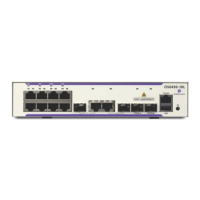Configuring 802.1AB 802.1AB Overview
OmniSwitch AOS Release 7 Network Configuration Guide March 2011 page 10-7
When an 802.1AB supporting system receives an LLDPDU containing MED capability TLV, then the
remote device is identified as an edge device , for example, IP phone and IP PBX, among others. In such a
case, the switch stops sending LLDPDU and starts sending MED LLDPDU on the port connected to the
edge device.
LLDP-Media Endpoint Devices
LLDP-MED is an extension to 802.1ab (Link Layer Discovery Protocol - LLDP), a link-layer protocol
that defines a method for network access devices using Ethernet connectivity to advertise device
information, device capabilities and media specific configuration information periodically to peer devices
attached to the same network.
The LLDP-MED feature facilitates the information sharing between Media Endpoint Devices and
Network Infrastructure Devices. It is designed to allow the following functionalities:
• Auto-discovery of LAN policies (such as VLAN, Layer 2 Priority and Diffserv settings) leading to
"plug and play" networking. This is achieved by advertising the VLAN information.
• Device location discovery to allow creation of location databases for VoIP, E911 services.
• Extended and automated power management of Power-over-Ethernet endpoints.
• Inventory management, allowing network administrators to track their network devices, and determine
their characteristics (manufacturer, software and hardware versions, and serial / asset number).
• Support for receiving, storing and advertising of VLAN information from and to remote Network
Connectivity Devices and Media Endpoint Devices (MEDs). LLDP-MED Network Policy TLVs are
used to let the OmniSwitch advertise the VLAN to the connected MEDs.
• Support for receiving and storing of Inventory Management TLVs from remote Media Endpoint
Devices.
VLAN assignment through explicit LLDP-MED Network Policy is supported on the OmniSwitch AOS.
• The LLDP-MED service advertises the information over the Logical Link-Layer Control Frames and
records higher layer management reachability and connection endpoint information from adjacent
devices.
• The LLDP-MED service enabled on OmniSwitch operates in advertising mode. However, it does not
support any means for soliciting information from the MEDs.
LLDP-MED Network Policy
The network policies for MED devices can be configured on the OmniSwitch using the LLDP-MED CLI
commands.
Network Policy - Application Types Supported
Each network policy can be configured with one application type as a mandatory parameter. The
following application types are supported:
• Voice
• Voice Signaling
• Guest Voice
• Guest Voice Signaling

